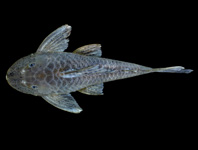Abstract
The banding sequence of the polytene chromosomes of Simulium armoricanum Doby & David from England, Portugal, and Spain was resolved relative to the standard map for the S. vernum group. The species is characterized by 11 fixed inversions, one nearly fixed inversion, and three common polymorphisms. The sister species of S. armoricanum is proposed as a formally undescribed species discovered in samples from Portugal. It shares one unique inversion with S. armoricanum, but otherwise differs by eight fixed or nearly fixed rearrangements. Simulium armoricanum and its newly discovered sister species, informally referred to as Simulium ‘IL-8’, are members of a larger clade of Palearctic species defined by a small pericentric inversion in chromosome III. Among the simuliid species occupying the same streams with S. armoricanum was the first record, chromosomally confirmed, of S. aureum Fries sensu stricto in Portugal. Successful chromosomal analysis of samples of S. armoricanum 17 years after initial fixation demonstrates the importance of storing cytologically fixed larvae at subzero temperatures.
References
Adler, P.H. & Crosskey, R.W. (2015) Cytotaxonomy of the Simuliidae (Diptera): a systematic and bibliographic conspectus. Zootaxa, 3975 (1), 1–139.
http://dx.doi.org/10.11646/zootaxa.3975.1.1Adler, P.H. & Crosskey, R.W. (2016) World Blackflies (Diptera: Simuliidae): A Comprehensive Revision of the Taxonomic and Geographical Inventory [2016]. Available from: http://www.clemson.edu/cafls/departments/esps/biomia/pdfs/blackflyinventory.pdf (accessed 17 May 2016)
Adler, P.H. & McCreadie, J.W. (2009) Black flies (Simuliidae). In: Mullen, G.R. & Durden, L.A. (Eds.), Medical and Veterinary Entomology. Elsevier, San Diego, CA. pp. 189–206.
Adler, P.H. & Seitz, G. (2014) Chromosomal characteristics and evolutionary relationships of the Palearctic black fly Simulium carthusiense (Diptera: Simuliidae). European Journal of Entomology, 111, 469–474.
http://dx.doi.org/10.14411/eje.2014.066Adler, P.H., Currie, D.C. & Wood, D.M. (2004) The Black Flies (Simuliidae) of North America. Cornell University Press, Ithaca, NY. xv + 941 pp. + 24 color plates.
Bass, J. (1998) Last-instar larvae and pupae of the Simuliidae of Britain and Ireland: a key with brief ecological notes. Institute of Freshwater Ecology, River Laboratory. Freshwater Biological Association Scientific Publication, 55, 1–102.
Bass, J.A.B. & Brockhouse, C. (1990) A new British species of the Simulium vernum group, with comments on its ecology and life history (Diptera: Simuliidae). Aquatic Insects, 12, 65–84.
http://dx.doi.org/10.1080/01650429009361392Bedo, D.G. (1989) A cytological study of Simulium ruficorne (Diptera: Simuliidae) and its relationship to the S. ornatipes species complex. Genome, 32, 570–579.
http://dx.doi.org/10.1139/g89-484Brockhouse, C. (1985) Sibling species and sex chromosomes in Eusimulium vernum (Diptera: Simuliidae). Canadian Journal of Zoology, 63, 2145–2161.
http://dx.doi.org/10.1139/z85-316Crosskey, R.W. & Crosskey, M. E. (2002) A breeding site survey of Simuliidae (blackflies) in South East England. Part 1: Sampling sites and species distribution records. Dipterists Digest, 9, 25–60.
Davies, L. (1966) The taxonomy of British black-flies (Diptera: Simuliidae). Transactions of the Royal Entomological Society of London, 118, 413–511.
http://dx.doi.org/10.1111/j.1365-2311.1966.tb00832.xDoby, J.-M. & David, F. (1961) Une nouvelle espèce du groupe “Simulium latipes”: Simulium armoricanum n. sp., (Diptères Simuliidés) récoltée dans l’ouest de la France. Bulletin de la Société Zoologique de France, 86, 230–235.
Golini, V.I. & Rothfels, K. (1984) The polytene chromosomes of North American blackflies in the Eusimulium canonicolum group (Diptera: Simuliidae). Canadian Journal of Zoology 62, 2097–2109.
http://dx.doi.org/10.1139/z84-304Grenier, P. & Dorier, A. (1959) Deux Simulies nouvelles (S. bertrandi n. sp. et S. carthusiense n. sp.) du Groupe latipes, récoltées en France et en Espagne. Travaux du Laboratoire d’Hydrobiologie et de Pisciculture de l’Université de Grenoble 40/41, 1–19.
Hunter, F.F. (1987) Cytotaxonomy of four European species in the Eusimulium vernum group (Diptera: Simuliidae). Canadian Journal of Zoology, 65, 3102–3115.
http://dx.doi.org/10.1139/z87-470Hunter, F.F. & Connolly, V. (1986) A cytotaxonomic investigation of seven species in the Eusimulium vernum group (Diptera: Simuliidae). Canadian Journal of Zoology, 64, 296–311.
http://dx.doi.org/10.1139/z86-050Ilmonen, J., Adler, P.H., Malmqvist, B. & Cywinska, A. (2009) The Simulium vernum group (Diptera: Simuliidae) in Europe: multiple character sets for assessing species status. Zoological Journal of the Linnean Society, 156, 847–863.
http://dx.doi.org/10.1111/j.1096-3642.2009.00500.xRaastad, J.E., Usova, Z.V. & Kuusela, K. (2010) Blackflies of Northern Europe (Diptera: Simuliidae). World Biodiversity Database Compact Disc Series. ETI Bioinformatics. University of Amsterdam, Netherlands.
Rothfels, K.H. & Dunbar, R.W. (1953) The salivary gland chromosomes of the black fly Simulium vittatum Zett. Canadian Journal of Zoology, 31, 226–241.
http://dx.doi.org/10.1139/z53-020Seitz, G. & Adler, P.H. (2009) A new species of the Simulium vernum group (Diptera: Simuliidae) from the Alps of southeastern Germany. Aquatic Insects, 31, 1–10.
http://dx.doi.org/10.1080/01650420802425158Seitz, G., Adler, P.H. & Forster, M. (2015) A new species, Simulium (Nevermannia) berchtesgadense (Diptera: Simuliidae), and its chromosomes, from the Alps of southeastern Germany. Zootaxa, 3937 (2), 248–262.
http://dx.doi.org/10.11646/zootaxa.3937.2.2

